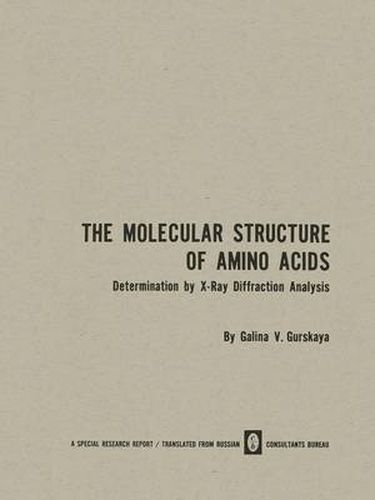Readings Newsletter
Become a Readings Member to make your shopping experience even easier.
Sign in or sign up for free!
You’re not far away from qualifying for FREE standard shipping within Australia
You’ve qualified for FREE standard shipping within Australia
The cart is loading…






This title is printed to order. This book may have been self-published. If so, we cannot guarantee the quality of the content. In the main most books will have gone through the editing process however some may not. We therefore suggest that you be aware of this before ordering this book. If in doubt check either the author or publisher’s details as we are unable to accept any returns unless they are faulty. Please contact us if you have any questions.
The last decade has seen great progress in the study'of the structure and functions of living organisms at the molecular level; molecular biology has become a new branch of science [1-16]. One of the major problems of molecular biology concerns the structure of proteins. Some information about protein structure is provided by the electron microscope, by the ultracentrifuge, and by small-angle x-ray scattering; the last gives the fullest information about the atomic structure of protein molecules, but x-ray study of biological objects represents a difficult and laborious task. In this way the struc- tures of three proteins have been established: hemoglobin, myoglobin [2, 8J, and lysozyme [10]; work has begun on ribonuclease, insulin, chymo- trypSin, carboxypeptidase, and so on [14-16]. A knowledge of the structures of amino acids and peptides is of con- siderable value in elucidating the structure and functions of proteins. Near- ly all proteins consist largely of 22 principal amino acids, which are linked together in polypeptide chains. The peptide link always arises between an a-amino group and the carboxyl group in the next amino acid residue, so all polypeptide chains have the same backbone, to which are attached dif- ferent radicals R (Fig. 1).
$9.00 standard shipping within Australia
FREE standard shipping within Australia for orders over $100.00
Express & International shipping calculated at checkout
This title is printed to order. This book may have been self-published. If so, we cannot guarantee the quality of the content. In the main most books will have gone through the editing process however some may not. We therefore suggest that you be aware of this before ordering this book. If in doubt check either the author or publisher’s details as we are unable to accept any returns unless they are faulty. Please contact us if you have any questions.
The last decade has seen great progress in the study'of the structure and functions of living organisms at the molecular level; molecular biology has become a new branch of science [1-16]. One of the major problems of molecular biology concerns the structure of proteins. Some information about protein structure is provided by the electron microscope, by the ultracentrifuge, and by small-angle x-ray scattering; the last gives the fullest information about the atomic structure of protein molecules, but x-ray study of biological objects represents a difficult and laborious task. In this way the struc- tures of three proteins have been established: hemoglobin, myoglobin [2, 8J, and lysozyme [10]; work has begun on ribonuclease, insulin, chymo- trypSin, carboxypeptidase, and so on [14-16]. A knowledge of the structures of amino acids and peptides is of con- siderable value in elucidating the structure and functions of proteins. Near- ly all proteins consist largely of 22 principal amino acids, which are linked together in polypeptide chains. The peptide link always arises between an a-amino group and the carboxyl group in the next amino acid residue, so all polypeptide chains have the same backbone, to which are attached dif- ferent radicals R (Fig. 1).